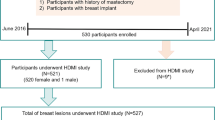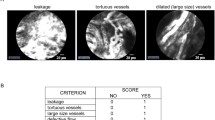Abstract
PURPOSE: Although angiogenesis assessed by immunostaining endothelial cells (microvessel density) is a well-known prognostic factor in a wide variety of human solid tumors, preoperative determination of microvessel density seems to be difficult in rectal carcinoma. Thus, we performed transanal color Doppler ultrasonography in 46 patients with rectal carcinoma to assess preoperative angiogenic status and compare it with microvessel density in surgical specimens. METHODS: Time-averaged maximal velocity, peak systolic velocity, number of vascular points, and vascular point index were conducted by color Doppler ultrasonography in 46 patients with rectal carcinoma. Number of vascular points was defined as the number of vessels with pulsation in the section of tumor. Vascular point index was defined as the average number of vascular points divided by the area assessed by color Doppler ultrasonography in the section of tumor. The profiles of number of vascular points were similar to those assessed by microangiography in five rectal carcinomas. RESULTS: Vascular point index significantly correlated with microvessel density (P<0.0001). No significant correlation was found between microvessel density and time-averaged maximal velocity or peak systolic velocity. Vascular point index was also a better indicator of lymph node metastasis and venous invasion than microvessel density. In addition, 11 of 46 cases with postoperative hematogenous metastasis (23.9 percent) were observed prospectively. Vascular point index may be a best predictor for hematogenous metastasis from rectal carcinoma compared with peak systolic velocity, time-averaged maximal velocity, and microvessel density by receiver operating characteristic analysis. CONCLUSION: These results suggest that preoperative quantification of angiogenesis using color Doppler ultrasonography will provide quick and useful information in the management of rectal carcinoma.
Similar content being viewed by others
References
Marcus EA, Weber TK, Rodriguez-Bigas MA, Driscoll D, Meropol NJ, Petrelli NJ. Prognostic factors affecting survival inpatients with colorectal carcinomatosis. Cancer Invest 1999;17:249–52.
Folkman J, Watson K, Ingber D, Hanahan D. Induction of angiogenesis during the transition from hyperplasia to neoplasia. Nature 1989;338:58–61.
Gimbrone MA, Cotran RS, Leapman S, Folkman J. Tumor growth neovascularization: an experimental model using rabbit cornea. J Natl Cancer Inst 1974;52:413–27.
Liotta LA, Steeg PS, Stetler-Stevenson WG. Cancer metastasis and angiogenesis: an imbalance of positive and negative regulation. Cell 1991;64:327–36.
Weidner N, Semple JP, Welch WR, Folkman J. Tumor angiogenesis and metastasis—correlation in invasive breast carcinoma. N Engl J Med 1991;324:1–8.
Hollingsworth HC, Kohn EC, Steinberg SM, Rothenberg ML, Merino MJ. Tumor angiogenesis in advanced stage ovarian carcinoma. Am J Pathol 1995;147:33–41.
Weinder N, Carroll PR, Flax J, Blumenfeld W, Folkman J. Tumor angiogenesis correlates with metastasis in invasive prostate carcinoma. Am J Pathol 1993;143:401–9.
Macchiarini P, Fontanini G, Hardin MJ, Squartini F, Angeletti CA. Relation of neovascularization to metastasis of non-small-cell lung cancer. Lancet 1992;340:145–6.
Maeda K, Chung YS, Takatsuka S,et al. Tumor angiogenesis as a predictor of recurrence in gastric carcinoma. J Clin Oncol 1995;13:477–81.
Takebayashi Y, Akiyama S, Yamada K, Akiba S, Aikou T. Angiogenesis as an unfavorable prognostic factor in human colorectal carcinoma. Cancer 1996;78:226–31.
Takebayashi Y, Akiyama S, Yamada K, Akiba S, Aikou T. Angiogenesis as an unfavorable prognostic factor in human colorectal carcinoma. Cancer 1996;78:226–31.
Tanigawa N, Amaya H, Matsumura M,et al. Extent of tumor vascularization correlates with prognosis and hematogenous metastasis in gastric carcinomas. Cancer Res 1996;56:2671–6.
Lagalla R, Caruso G, Marasa L, D'Angelo I, Cardinale AE. Angiogenic capacity of breast neoplasm and correlation with color Doppler semiology. Radiol Med 1994;88:392–5.
Lee WJ, Chu JS, Houng SJ, Chung MF, Wang SM, Chen KM. Breast cancer angiogenesis: a quantitative morphologic and Doppler imaging study. Ann Surg Oncol 1995;2:246–51.
Hata K, Hata T, Maruyama M, Hirai R. Uterine sarcoma: can it be differentiated from uterine leiomyoma with Doppler ultrasonography? Ultrasound Obstet Gynecol 1997;10:101–4.
Emoto M, Iwasaki H, Mimura K, Kawarabayashi T, Kikuchi M. Differences in the angiogenesis of benign and malignant ovarian tumors demonstrated by analyses of color Doppler ultrasound, immunohistochemistry, and microvessel density. Cancer 1997;80:899–907.
Chen WF, Chen TM, Chen CA,et al. Clinical application of intratumoral blood flow study in patients with endometrial carcinoma. Cancer 1998;82:1881–6.
Cheng WF, Lee CN, Chu JS,et al. Vascularity index as a novel parameter for the in vivo assessment of angiogenesis in patients with cervical carcinoma. Cancer 1999;85:651–7.
Hata K, Hata T, Collins WP. Association of thymidine phosphorylase concentration with ultrasound-derived indices of blood flow in ovarian masses. Cancer 1997;80:1079–84.
Jass JR, Sobin LH. World Health Organization International histological classification of tumor: histological typing of intestinal tumors. 2nd ed. New York: Springer-Verlag, 1989.
Astler VB, Coller FA. The prognostic significance of direct extension of carcinoma of the colon and rectum. Ann Surg 1954;139:846–52
Hsu SM, Raine L, Fanger AH. A comparative study of the peroxidase method: an avidin-biotin complex method for studying polypeptide hormones with radioimmunoassay antibody. Am J Clin Pathol 1981;75:734–8.
Mauceri HJ, Hanna NN, Beckett MA,et al. Combined effects of angiostatin and ionizing radiation in antitumour therapy. Nature 1998;16:394:287–91.
Leenders WP. Targetting VEGF in anti-angiogenic and anti-tumor therapy: where are we now? Int J Exp Pathol 1998;79:339–46.
Matsushita S, Nitanda T, Furukawa T,et al. The effect of a thymidine phosphorylase inhibitor on angiogenesis and apoptosis in tumors. Cancer Res 1999;15:59:1911–6.
Author information
Authors and Affiliations
Additional information
Supported a grant from Ogura Memorial Hospital.
About this article
Cite this article
Ogura, O., Takebayashi, Y., Sameshima, T. et al. Preoperative assessment of vascularity by color Doppler ultrasonography in human rectal carcinoma. Dis Colon Rectum 44, 538–546 (2001). https://doi.org/10.1007/BF02234326
Issue Date:
DOI: https://doi.org/10.1007/BF02234326




